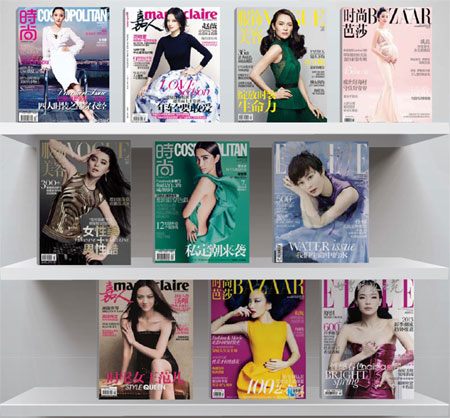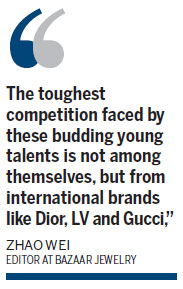

|
Zhang Ziyi on the cover of Esquire, wearing a samurai-style robe designed by Jiang Yi. Provided to China Daily |

There are only so many celebrities and there is a crowd of eager designers fighting to dress them. Zhao Xu looks at the mechanics and politics of Who Dresses Who.
Given the number of independent Chinese fashion designers who have risen to prominence in the last few years, you would think they would be trampling over each other in their fight to dress screen celebrities for fashion magazine covers, or the red carpet.
But that's not quite what's happening, according to Zhao Wei, the editor at Bazaar Jewelry who organizes such projects, and regularly attends international fashion weeks in Paris and Milan.
"As far as magazine exposure is concerned, the toughest competition faced by these budding young talents is not among themselves, but from international brands like Dior, LV and Gucci," she says.
"These big-name designers not only enjoy a near-total monopoly over the covers of all first-league fashion publications, but also dominate the inner pages where stars are seen wrapped in Chanel chiffon, or Gucci leather, or the latest Louis Vuitton chessboard print.
"For every 10 photographs a star takes, for say, a magazine interview, only one or at most two will feature a dress from a Chinese designer," she estimates.
It would be unfair to heap all the blame on big luxury brands for their "page aggression", according to Shi Zhiqiang, fashion editor at the Chinese edition of Timeout Beijing, a fortnightly city lifestyle guide.
|
 |
|
 |
"There's a reason they are given preference over domestic designer creations. These luxury brands have been around for decades, and they are mature in both the design and production process," he says.
"The advantage shows in all aspects, from fabric to cutting and finish. You can see it at once when the dresses are worn on real people."
What Shi is saying mirrors the pressure of running against the clock to photograph a celebrity with a tight schedule who cannot be expected to change in and out of clothes too many times.
The assurance of quality and cut with the big name brands helps optimize time and opportunity.
"Put a handful of top brands together and you have a safe recipe for the season's most 'in' stuff," Shi says. "I'm not saying that independent designers' works are not beautiful and trendy, but they can also be too idiosyncratic and whimsical for anybody to pull off."
Clothes aside, another factor that has worked against local designers is the highly effective public relations strategies of the international designers. In contrast, homegrown brands have a limp, if not non-existent PR push.
"Through their specialized and dedicated PR teams, all international brands have established and maintained an extremely beneficial relationship with major fashion publications," says Zhao from Bazaar Jewelry.
"Local designers are only just starting to have the awareness to send e-mail updates or knock directly on our doors. Most do not have the time and resources to market their creations. And there're even some who are still very wary of the idea of 'exposure', fearing plagiarism.
"That mindset, to me, is just ridiculous, and speaks of a lack of confidence on the part of the designer."
The celebrity models, too, are understandably more willing to be associated with an established brand that will subtly enhance their star quotient. That some of these stars are household names who are paid to endorse certain brands may also make them think twice about designs from a rival brand.
Every season, an international designer such as Christian Dior will fly no more than 20 pieces of a new collection to China, for publicity shoots.
These clothes are hotly competed for, among hundreds of fashion and style magazines. As a result, some pieces may actually be "over exposed" and the awkward situation of stars wearing the same outfits may occur.
It has not resulted in the attraction of big names diminishing, nor has it helped local designers gain a broader showcase. This can probably be explained by one single driving factor, according to Zhao: economics.
"With their double or multi page advertisements for fashion, jewelry and perfume, international luxury brands are major clients of leading fashion magazines. Sometimes it is written in the contract, sometimes it is not - but the invisible hand of the bottom line is always there to decide and dictate editorial policy," she says.
"There's a limit to how much we can do to help our own designers."
But not everyone is going to take it hard. Jiang Yi, a Beijing-based independent designer, commented on the situation with no apparent resentment.
"Let's face it: The big brands sit on the top of the food chain, in the middle are the fashion magazines, and we are at the bottom," he says. "And that's what it's like when you are in the open marketplace."